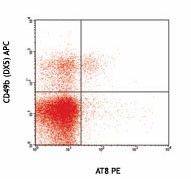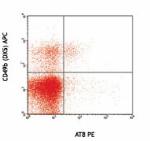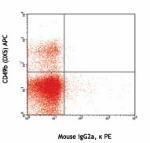- Clone
- AT8 (See other available formats)
- Regulatory Status
- RUO
- Other Names
- Ly-49G, Ly49g, Killer cell lectin-like receptor 7, Klra7
- Isotype
- Mouse IgG2a, κ
- Ave. Rating
- Submit a Review
- Product Citations
- publications

-

Balb/c mouse splenocytes stained with CD49b (DX5) APC and AT8 PE (top) or mouse IgG2a, κ PE isotype control (bottom). -

Ly49G is a type II transmembrane protein belonging to the family of Ly49 proteins, each having specificity for a small repertoire of MHC I alleles that are generally recognized in a peptide-independent manner. The Ly49 family of MHC class I receptors shows a high degree of variability between mouse strains. It is expressed on a subset of NK cells and some NKT cell lines. The AT8 antibody reacts with the Ly49G receptor from BALB/c, 129/J, 129Sv/J, SJL, FVB/N, A/J, C3H/HeJ, C3H/HeNCr, CBA/J, and CBA/NCr mice.
Product DetailsProduct Details
- Verified Reactivity
- Mouse
- Antibody Type
- Monoclonal
- Host Species
- Mouse
- Immunogen
- IL-2-activated 129/J NK cells
- Formulation
- Phosphate-buffered solution, pH 7.2, containing 0.09% sodium azide.
- Preparation
- The antibody was purified by affinity chromatography.
- Concentration
- 0.5 mg/mL
- Storage & Handling
- The antibody solution should be stored undiluted between 2°C and 8°C.
- Application
-
FC - Quality tested
- Recommended Usage
-
Each lot of this antibody is quality control tested by immunofluorescent staining with flow cytometric analysis. For flow cytometric staining, the suggested use of this reagent is ≤ 1.0 µg per 106 cells in 100 µL volume. It is recommended that the reagent be titrated for optimal performance for each application.
-
Application References
(PubMed link indicates BioLegend citation) -
- Makrigiannis AP, et al. 2004. J. Immunol. 172:1414.
- RRID
-
AB_10551620 (BioLegend Cat. No. 137402)
Antigen Details
- Structure
- A type II transmembrane protein belonging to Ly49 family.
- Distribution
-
Subset of NK cells and some NKT cell lines
- Function
- Allele-specific MHC recognition
- Ligand/Receptor
- MHC class I molecules
- Cell Type
- NK cells, NKT cells
- Biology Area
- Immunology, Innate Immunity
- Molecular Family
- MHC Antigens
- Antigen References
-
- Lavender KJ, et al. 2006. J. Immunol. 177:8578.
- Pascal V, et al. 2007. J. Immunol.. 179:1751.
- Lavender KJ, et al. 2007. J. Immunol. 179:6856.
- Rouhi A, et al. 2007. Mol. Immunol. 44(5):821.
- Gene ID
- 16638 View all products for this Gene ID
- UniProt
- View information about Ly49G on UniProt.org
Related Pages & Pathways
Pages
Other Formats
View All Ly49G Reagents Request Custom Conjugation| Description | Clone | Applications |
|---|---|---|
| Purified anti-mouse Ly49G | AT8 | FC |
| TotalSeq™-C0840 anti-mouse Ly49G | AT8 | PG |
| TotalSeq™-B0840 anti-mouse Ly49G Antibody | AT8 | PG |
| TotalSeq™-A0840 anti-mouse Ly49G | AT8 | PG |
Compare Data Across All Formats
This data display is provided for general comparisons between formats.
Your actual data may vary due to variations in samples, target cells, instruments and their settings, staining conditions, and other factors.
If you need assistance with selecting the best format contact our expert technical support team.
-
Purified anti-mouse Ly49G

Balb/c mouse splenocytes stained with CD49b (DX5) APC and AT... 
-
TotalSeq™-C0840 anti-mouse Ly49G
-
TotalSeq™-B0840 anti-mouse Ly49G Antibody
-
TotalSeq™-A0840 anti-mouse Ly49G







Follow Us